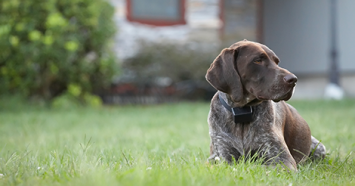
In my grandparents’ day, dogs ran loose around the neighborhood. I have fond memories of their English Setter, Butch, resting on their porch during the heat of a summer day, but in the mornings and evenings, he was always gone.
Unfortunately, it’s not safe for dogs to roam as Butch had. With the risk of car accidents, predators, dog fights, and theft, a free-roaming dog is much safer while in your fenced yard. But with the debate between invisible fence versus a traditional fence, which is better? If you’re in the market for a fence, read on to learn about the pros and cons of invisible fences.
Traditional Fences vs Invisible Fences
For most dogs, the best way to keep them safe is to install a fence around the yard. However, bring up the subject of invisible fences and tempers flare. Invisible fences, of which there are many brands and types, consist of a hidden electronic wire that reacts with a collar to provide a signal to the dog via a collar bring out strong reactions on both sides of the subject.
The Pros
Chain link, solid wood, and vinyl fences are costly whereas, in most cases, professionally installed invisible fencing costs less.
Invisible fencing is easily adapted to odd sized or shaped yards, rough terrain, hills, wooded lots, or other situations where traditional fencing might be hard to build.
Invisible fencing can be used in conjunction with traditional fencing. Installed inside a traditional fence, the invisible fence can help keep in that dog who wishes to climb or dig under the traditional fence.
Because it can’t be seen, the invisible fence enhances your landscaping rather than detracting from it as so many traditional fences do.
The Cons
A traditional fence keeps your dog inside by creating a physical barrier. Invisible fences require training to teach the dog where the wire is and what happens when they get too close. For the invisible fence to be effective, training must be done and refreshed regularly.
Some dogs become agitated and frustrated when they see neighborhood kids and dogs playing on the other side of the invisible fence. This can cause barking, charging the fence, or sometimes simply running through it despite the warning sound and shock. Running through the fence may also happen when something frightens the dog, such as a thunderstorm.
The warning sound and shock doesn’t only happen when the dog leaves the area, it also happens when they return. Once they’re outside the invisible fence, they’re not likely going to come back since they’ll be shocked again.
An invisible fence keeps dogs from leaving the area, but it does not prevent others from coming in. Strangers, loose dogs, and other predators can run through the invisible barrier, putting everyone at risk.
Making a Choice
Choosing the right fence for you and your dog is a personal decision. Look at the pros and cons of invisible fences as well as traditional fences. Think about your yard, landscaping, terrain, and where you would like your dog to have access. Think about your dog’s personality. Are they an escape artist? Would they panic if they got a shock from the collar? Would they become a problem barker if they saw dogs and kids playing in front of them?
You might just find that you’re better off with a combination of both types of fences: a traditional fence around the outside of the yard and an invisible fence inside to create a barrier to protect your landscaping or to keep your dog from trying to escape.